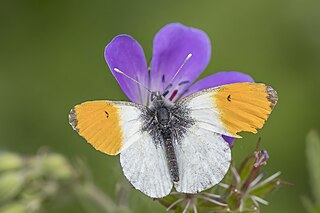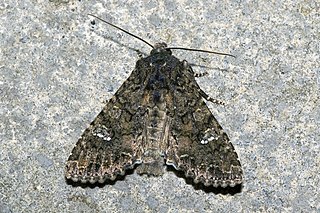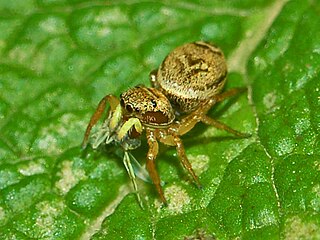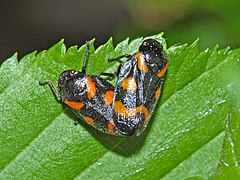
The froghoppers, or the superfamily Cercopoidea, are a group of hemipteran insects in the suborder Auchenorrhyncha. Adults are capable of jumping many times their height and length, giving the group their common name, but many species are best known for their plant-sucking nymphs which produce foam shelters, and are referred to as "spittlebugs".

Anthocharis cardamines, the orange tip, is a butterfly in the family Pieridae, which contains about 1,100 species. A. cardamines is mainly found throughout Europe and temperate Asia (Palearctic) The males feature wings with a signature orange pigmentation, which is the origin of A. cardamines' common name.

The katipō is an endangered species of spider native to New Zealand. It is one of many species in the genus Latrodectus, such as the Australian redback, and the North American black widow. The species is venomous to humans, capable of delivering a potentially dangerous bite. It is a small to medium-sized spider, with the female having a round black or brown pea-sized body. Red katipō females found in the South Island and the lower half of the North Island, are always black, and their abdomen has a distinctive red stripe bordered in white. In black katipō females found in the upper half of the North Island, this stripe is absent, pale, yellow, or replaced with cream-coloured blotches. These two forms were previously thought to be separate species. The male is much smaller than the female and quite different in appearance: white with black stripes and red diamond-shaped markings. Katipō are mainly found living in sand dunes close to the seashore. They are found throughout most of coastal New Zealand except the far south and west. Katipō feed mainly on ground dwelling insects, caught in an irregular tangled web spun amongst dune plants or other debris.

Enallagma cyathigerum is a species found mainly between latitudes 40°N and 72°N; It is widely distributed in the Palearctic, and the Nearctic species Enallagma annexum was at one time considered to be synonymous with it. The species can reach a length of 32 to 35 mm. It is common in many different countries including Russia, Sweden, Norway, Finland, the United States of America, and South Korea. Damselflies are an important link between the health of the aquatic ecosystem and its response to climate change.

The beautiful demoiselle is a species of damselfly belonging to the family Calopterygidae. It is found in Europe, North Africa, and Western Asia. It is often found along fast-flowing waters.

The large red damselfly is a species of damselflies belonging to the family Coenagrionidae. It is native to the western Palearctic.

The red river hog or bushpig is a wild member of the pig family living in Africa, with most of its distribution in the Guinean and Congolian forests. It is rarely seen away from rainforests, and generally prefers areas near rivers or swamps.

The cabbage moth is primarily known as a pest that is responsible for severe crop damage of a wide variety of plant species. The common name, cabbage moth, is a misnomer as the species feeds on many fruits, vegetables, and crops in the genus Brassica. Other notable host plants include tobacco, sunflower, and tomato, making this pest species particularly economically damaging.

The southern hawker or blue hawker is a species of hawker dragonfly.

The ruddy darter is a species of dragonfly of the family Libellulidae.

Graphium agamemnon, the tailed jay, is a predominantly green and black tropical butterfly that belongs to the swallowtail family. The butterfly is also called the green-spotted triangle, tailed green jay, or green triangle. It is a common, non-threatened species native to Nepal, India, Sri Lanka through Southeast Asia and Australia. Several geographic races are recognized. The species was first described by Carl Linnaeus in his 1758 10th edition of Systema Naturae.

Phidippus californicus is a species of jumping spider. It is found in the southwestern United States and northern Mexico.

Cercopis vulnerata is a species of froghopper in the family Cercopidae.

The Odessa barb is a species of cyprinid fish known from Central Myanmar, where it is known to occur in an artificial pond above the Anisakan Falls and also from the lower Chindwin River. For many years it has been known to the aquarium hobby, where it has frequently been confused with the less colourful ticto barb, but it was only described scientifically in 2008.

Aphrophora alni, the European alder spittle bug, is a species belonging to the family Aphrophoridae.

Philaenus spumarius, the meadow froghopper or meadow spittlebug, is a species of insect belonging to the spittlebug family Aphrophoridae. In Italy and America, it is economically important as one of the vectors of Pierce's disease.

Heliophanus tribulosus is a species of 'jumping spiders' belonging to the family Salticidae.

Prosapia bicincta, the two-lined spittlebug, is a species of insect in the family Cercopidae. Adults are black with two red or orange lines crossing the wings. It reaches a length of 8–10 mm. It is widespread in the eastern half of the United States. A similar species, Prosapia simulans, can be found throughout Central America where it is considered an agricultural pest.

Cercopis is a genus of froghoppers belonging to the family Cercopidae, distributed primarily in the Palearctic. At least one species, C. vulnerata, can be a pest to agriculture. There are over 30 accepted species.
Tropidurus melanopleurus, the black lava lizard, is a species of lizard from the Andean region of western South America, ranging between the three different countries of Peru, Bolivia, and Argentina. It was described in 1902 by zoologist George Boulenger. It is fairly small in size, but is known for its different appearance and differing size between the males and females. However, while the patterns of color may be different between the sexes, both males and females have a very distinct physical color array with a patterned mix of green, orange, cream, black and or brown. This species of lizard lives in a generally warm to hot climate all year round and spends most of its day on the side of vertical rock structures in the mountains, feeding on various types of insects, with an emphasis on ants.





















